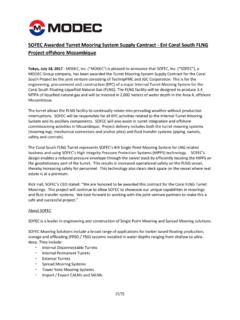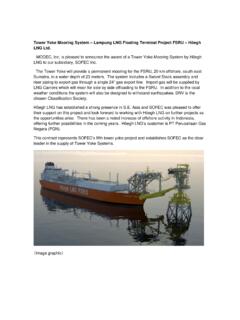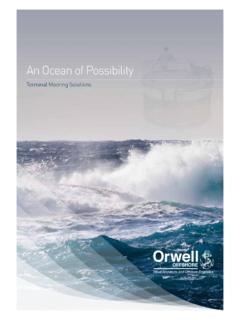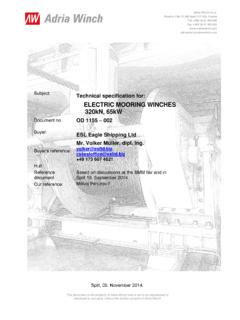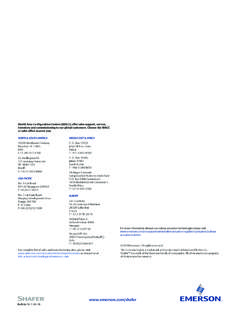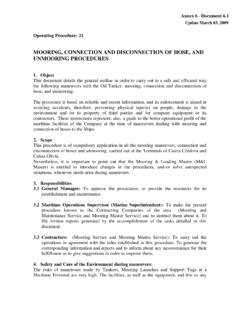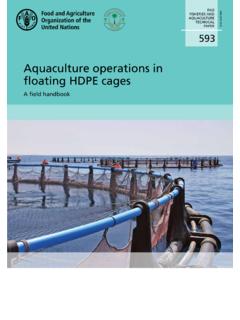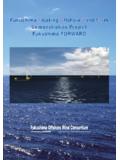Transcription of Bridge Procedures Guide - Shipboard Training - METC
1 Has the operation of the following equipment been studied and fully understood? Bridge and deck lightingemergency arrangements in the event of main power failurenavigation and signal lights, includingsearchlightssignalling lampmorse lightsound signalling apparatus, includingwhistlesfog bell and gong systemsafety equipment, includingLSA equipment including pyrotechnics, EPIRB and SART Bridge fire detection panelgeneral and fire alarm signalling arrangementsemergency pump, ventilation and watertight door controlsinternal ship communications facilities, includingportable radiosemergency batteryless telephone systempublic address systemAIS and external communication equipment, includingVHF and GMDSS equipmentalarm systems on bridgeautomatic track-keeping system, if fittedECDIS and electronic charts, if fittedecho sounderelectronic navigational position-fixing systemsVDR or S-VDR equipmentgyro compass/repeatersIBS functions, if fittedmagnetic compassoff-course alarmradar including ARPA speed/distance recorderengine and thruster controlsBridge Procedures guideB1 Familiarisation with Bridge equipmentPart B Bridge ChecklistExtracted from ICS Bridge Procedure Guide Compiled by: MaluyaHas a passage plan for the intended voyage been prepared?
2 (see section 2)Has the following equipment been checked and found ready for use?anchorsbridge movement book/course and engine movement recorderecho sounderelectronic navigational position-fixing systemsgyro/magnetic compass and repeaterspassage plan entered into integrated Bridge systemradar(s)required AIS data inputs made, speed/distance recorderclocksHas the following equipment been tested, synchronised and found ready for use? Bridge and engine room telegraphs, includingrpm indicatorsemergency engine stopsthruster controls and indicators, if fittedcontrollable pitch propeller controls and indicators, if fittedcommunications facilities, includingbridge to engine room/mooring station communicationsportable radiosVHF radio communications with port authoritynavigation and signal lights, includingsearchlightssignalling lampmorse lightsound signalling apparatus, includingwhistlesfog bell and gong systemsteering gear, including manual, auto-pilot and emergencychangeover arrangements and rudder indicators(see annex A7)window wiper/clearview screen arrangementsIs the ship secure for sea?
3 Cargo and cargo handling equipment secureall hull openings secure and watertightcargo/passenger details availablestability and draught information availableBridge Procedures guideB2 Preparation for seaPart B Bridge ChecklistExtracted from ICS Bridge Procedure Guide Compiled by: MaluyaIn preparing the passage for arrival in port, has a pre-pilotageinformation exchange taken place?(see annexes A1 and A2)Has the passage plan been updated following receipt of the Shore-to-ShipPilot/Master Exchange form and all latest navigational warnings?Has the ETA been sent with all relevant information required by local regulations( details of dangerous/hazardous goods carried)?Is it necessary to rearrange cargo/ballast?Has the following equipment been prepared and checked?course and engine movement recordersclock synchronisationcommunications with the engine control room and mooring stationssignalling equipment, including flags/lightsdeck lightingmooring winches and lines, including heaving linespressure on fire mainanchors cleared awaystabilisers and log tubes housed, if fittedHas the steering gear been tested, and has manual steering been engagedin sufficient time for the helmsman to become accustomed before manoeuvringcommences?
4 (see annex A7)Have the engines been tested and prepared for manoeuvring?Has the Pilot Card(see annex A3)been completed and are the pilot embarkationarrangements(see annex A5)in hand?Have VHF channels for the various services( VTS, pilot, tugs, berthing instructions)been noted and a radio check carried out?Has the port been made fully aware of any special berthing requirementsthat the ship may have?Other checks: Bridge Procedures guideB3 Preparation for arrival in portPart B Bridge ChecklistExtracted from ICS Bridge Procedure Guide Compiled by: MaluyaImmediately on arrival on the Bridge , has the pilot been informed ofthe ship s heading, speed, engine setting and draught?Has the pilot been informed of the location of lifesaving appliancesprovided on board for his use?Have details of the proposed passage plan been discussed with thepilot and agreed with the master, including:radio communications and reporting requirementsbridge watch and crew stand-by arrangementsdeployment and use of tugsberthing/anchoring arrangementsexpected traffic during transitpilot change-over arrangements, if anyfender requirementsHas a completed Pilot Card(see annex A3)been handed to the pilot andhas the pilot been referred to the Wheelhouse Poster?
5 (see annex A4)Have the responsibilities within the Bridge team for the pilotage beendefined and are they clearly understood?Has the language to be used on the Bridge between the ship, the pilotand the shore been agreed?Are the progress of the ship and the execution of orders being monitoredby the master and officer of the watch?Are the engine room and ship s crew being regularly briefed on theprogress of the ship during the pilotage?Are the correct lights, flags and shapes being displayed?Other checks: Bridge Procedures guideB4 PilotagePart B Bridge ChecklistExtracted from ICS Bridge Procedure Guide Compiled by: MaluyaHave navigation charts been selected from chart catalogue, including:large scale charts for coastal watersappropriate scale charts for ocean passagesplanning chartsrouteing, climatic, pilot and load line zone chartsHave publications been selected, including:Sailing Directions and pilot bookslight listsradio signalsguides to port entrytide tables and tidal stream atlasHave all navigation charts and publications been corrected up to date, including:the ordering of new charts/publications, if necessarynotices to marinerslocal area warningsNAVAREA navigational warningsHave the following been considered?
6 Ship s departure and arrival draughts together with anyrestrictions on underkeel clearance due to squatship s cargo and any special cargo stowage/carriage restrictionsif there are any special ship operational requirements for the passageHave the following been checked?planning charts and publications for advice and recommendations on route to be takenclimatological information for weather characteristics of the areanavigation charts and publications for landfall featuresnavigation charts and publications for Ships Routeing Schemes,Ship Reporting Systems and Vessel Traffic Services (VTS)Has weather routeing been considered for passage?Have the following preparations been made for port arrival?navigation charts and publications studied for pilotage requirementsShip-to-Shore Master/Pilot Exchange form prepared (see annex A1)Pilot Card updated (see annex A3)port guides studied for port information including arrival/berthing restrictionsOther checks: Bridge Procedures guideB5 Passage plan appraisalPart B Bridge ChecklistExtracted from ICS Bridge Procedure Guide Compiled by: MaluyaHave the following factors been taken into consideration in preparing the passage plan?
7 Advice/recommendations in Sailing Directionsship s draught in relation to available water depthseffect of squat on underkeel clearance in shallow watertides and currentsweather, particularly in areas prone to poor visibilityavailable navigational aids and their accuracyposition-fixing methods to be useddaylight/night-time passing of danger pointstraffic likely to be encountered flow, type, volumeany requirements for traffic separation/routeing schemesship security considerations regarding piracy or armed attackAre local/coastal warning broadcasts being monitored?Is participation in area reporting systems recommended including VTS?Is the ship s position being fixed at regular intervals?Has equipment been regularly checked/tested, including:gyro/magnetic compass errorsmanual steering before entering coastal waters if automatic steeringhas been engaged for a prolonged periodradar performance and radar heading line marker alignmentecho sounderIs the OOW prepared to use the engines and call a look-out or a helmsman to the Bridge ?
8 Have all measures been taken to protect the environment from pollutionby the ship and to comply with applicable pollution regulations?Other checks: Bridge Procedures guideB6 Navigation in coastal watersPart B Bridge ChecklistExtracted from ICS Bridge Procedure Guide Compiled by: MaluyaIs keeping a look-out being given due priority?Are NAVAREA, HYDROLANT and HYDROPAC navigational warning broadcastsand other long-range weather reports being monitored closely?Are changes in the local weather being monitoredand is the barometer observed regularly?Is participation in area reporting systems ( AMVER) recommended?Is the ship s position being fixed at regular intervals?Are celestial navigational techniques being practised?Are gyro/magnetic compass errors and radar performance being checked regularly?Have radar techniques been practised (in clear visibility)?
9 Have preparations been made for landfall?Have measures been taken to protect the environment from pollutionby the ship and to comply with applicable pollution regulations?Other checks: Bridge Procedures guideB7 Navigation in ocean watersPart B Bridge ChecklistExtracted from ICS Bridge Procedure Guide Compiled by: MaluyaHas an anchoring plan been prepared taking into account:speed reduction in ample timedirection/strength of wind and currenttidal stream when manoeuvring at low speedsneed for adequate searoom particularly to seawarddepth of water, type of seabed and the scope of anchor cable requiredHave the engine room and anchor party been informedof the time of stand-by for anchoring?Are the anchors, lights/shapes and sound signalling apparatus ready for use?Has the anchor position of the ship been reported to the port authority?
10 While at anchor, the OOW should:determine and plot the ship s position on the appropriate chart as soon as practicablewhen circumstances permit, check at sufficiently frequent intervals whether the ship is remainingsecurely at anchor by taking bearings of fixed navigation marks or readily identifiable shore objectsensure that proper look-out is maintainedensure that inspection rounds of the ship are made periodicallyensure vessel access control precautions are maintained in respect of vessel securityobserve meteorological and tidal conditions and the state of the seanotify the master and undertake all necessary measures if the ship drags anchorensure that the state of readiness of the main engines and other machinery is inaccordance with the master s instructionsif visibility deteriorates, notify the masterensure that the ship exhibits the appropriate lights and shapes and that appropriate soundsignals are made in accordance with all applicable regulationstake measures to protect the environment from pollution by the shipand comply with applicable pollution regulationsOther checks: Bridge Procedures guideB8 Anchoring and anchor watchPart B Bridge ChecklistExtracted from ICS Bridge Procedure Guide Compiled by: MaluyaHas the following equipment been checked to ensure that it is fully operational?

